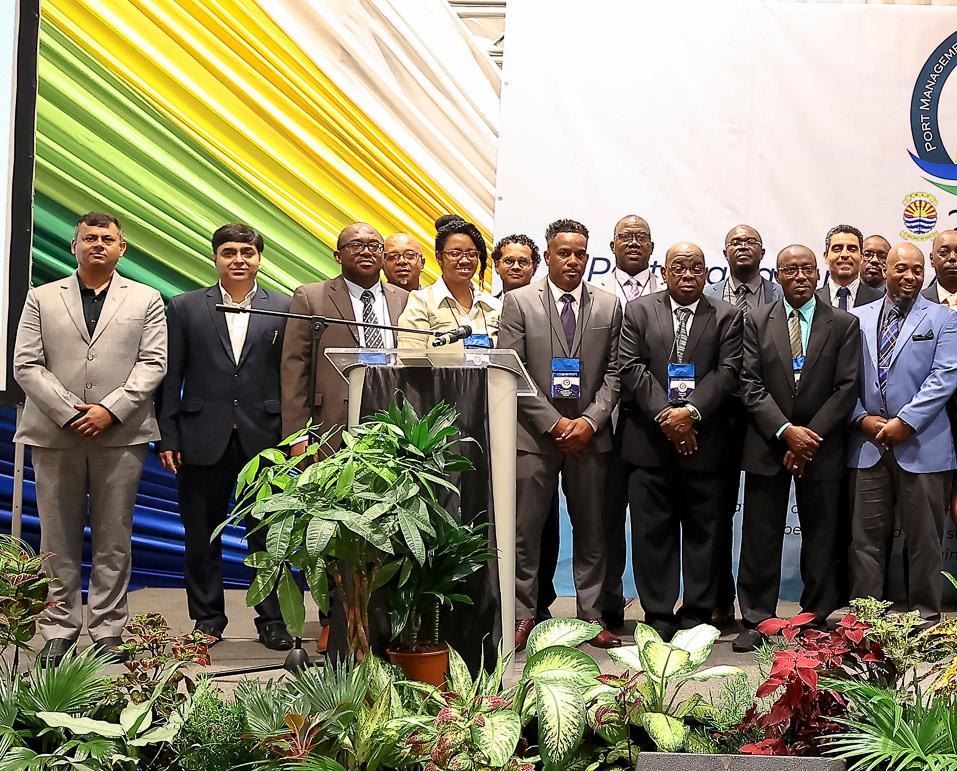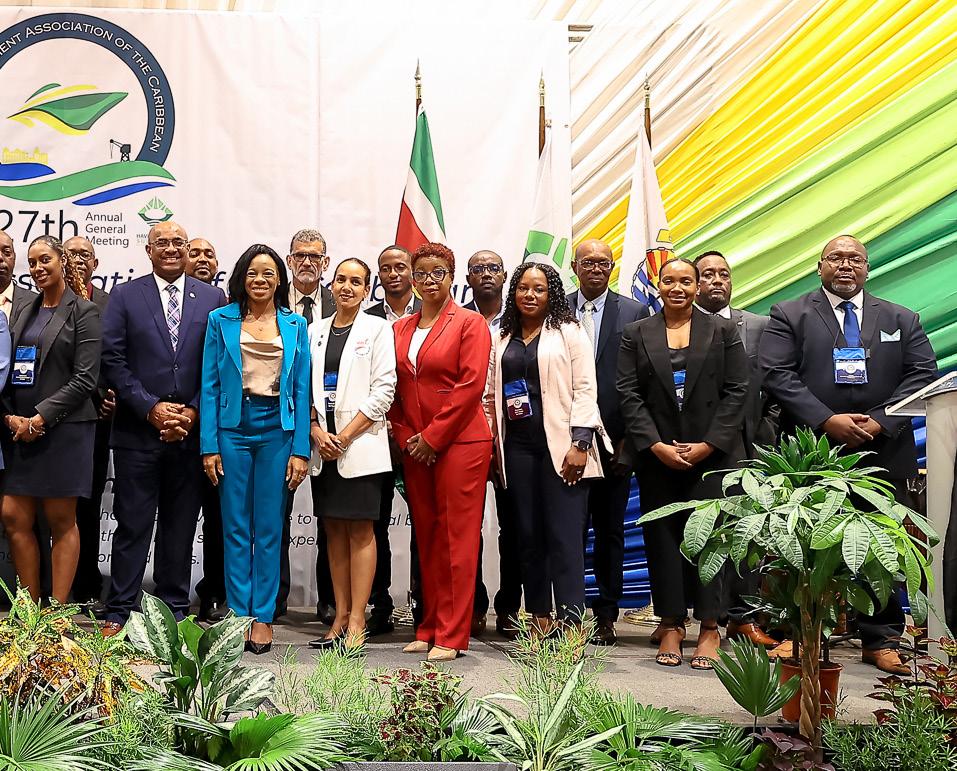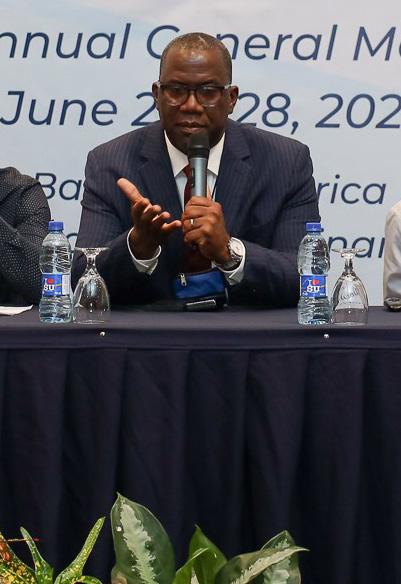








A hub for maritime trade, many Caribbean countries depend on shipping to import and export goods that meet the needs of its people but are faced with a number of modern-day challenges
Writer: Jack Salter | Project Manager: Deane Anderton

Caribbean ports are social entities that facilitate the very existence of people, enabling critical supplies such as food, clothing, and shelter to be received and transported across the region.
However, several challenges face the Caribbean when it comes to shipping, such as inadequate port infrastructure, environmental regulations, and high costs.
The former requires modernization, as several ports do not have the infrastructure to handle larger cargo volumes and ships, causing delays and increased costs for shippers who may opt to use other regional hubs as a result.
The limitations of this outdated infrastructure are exacerbated by environmental issues, as Caribbean ports are under strain from the demands of global regulations surrounding decarbonization.
Shipping costs, meanwhile, can be extremely high in
the Caribbean due to steep fuel prices, inefficient port operations, and limited competition among carriers.
These costs are substantially more than in other parts of the world, making it difficult for Caribbean businesses to complete on the global stage and increasing prices for consumers.
The impact of these various limitations is heightened even further in smaller Caribbean islands, where ports act as a gateway in and out of the country and are a pillar for their economic well-being.

Despite these challenges, cruise ships represent an exciting area of growth and development for ports as they have become an important part of the Caribbean economy.
However, many smaller ports in the region do not currently have the infrastructure or capacity to simultaneously handle both cargo and cruise vessels.

Darwin Telemaque, Chairman, discusses this integral role of the Port Management Association of the Caribbean as a node in the region’s ports network amid the modern challenges of digitalization and decarbonization

North America Outlook (NA): Firstly, could you introduce us to the Port Management Association of the Caribbean and outline your mission statement?

Darwin Telemaque, Chairman (DT):
The Port Management Association of the Caribbean (PMAC) is a small but vital organization established for the purposes of coordinating issues surrounding ports in the Caribbean. Some of these concerns relate to legislative, financial, and operational modernization and, most importantly, the human capacity development of our people. As we participate in a sector that is mostly driven by large multilaterals and builds systems that focus on the needs of very large companies, whether it be mechanization, digital solutions, legislation, or regulation, decisions are sometimes made outside of our capacity to influence and direct.
We are left to grapple with the evolution of an industry in which our capacity to influence is very limited. However, the sector remains pivotal and critical to the existence of our island nations, many of which are single port states and don’t own any vessels.
As the industry evolves, we are forced to adapt to change. Sometimes it’s technology, other times it’s the size of the vessels, requiring expansion to both our channels and our docks.
Challenges continue to arise, and in a world where the small is insignificant, where do we find the capacity that can alleviate our concerns through a global space? PMAC has emerged as that facilitating entity.
Our mission statement is to foster operational and financial efficiency and enhance the level of service to the mutual benefit of Caribbean ports and stakeholders through the sharing of experience, training, information management, and ideas.
As a matter of fact, we have decided just this year that we are going to realign our vision and our mission.

The Jamaica Special Economic Zone Authority has the perfect opportunity for you. Enjoy an array of fiscal and non-fiscal incentives aimed at taking your business to the next level, through increased production, reduced storage and production costs while increasing output.
Briefly introduce me to the Jamaica Special Economic Zone Authority (JSEZA), e.g. a short overview of your main products and services, locations, client base, number of employees, etc.
The Jamaica Special Economic Zone Authority (JSEZA) was established in 2016 under the Special Economic Zones (SEZ) Act, 2016.
The JSEZA main function is to facilitate developments within the SEZ regime in Jamaica. By offering a range of incentives, streamlined regulations, and excellent business facilitation to boost efficiency for business with SEZs. There are two main categories of incentives: fiscal and non-fiscal, that make it easy to hit the ground running. Some of these are:
SEZ Fiscal Incentives
• Corporate Income Tax (25 percent) reduced to 12.5 percent can be further reduced to 7.75 percent with the application of capital allowances, promotional tax credits and employment tax credits.
• Customs duty exemptions are available for goods imported and used in the SEZ.
• The SEZ Regime offers a 0 percent rate of General Consumption Tax (GCT) on locally purchased goods and services.
• Multi-Purpose Developers receive relief from income tax on rental income. *except for rentals where the landlord (whether the Developer or an Occupant) and tenant are connected persons within the meaning of the Income Tax Act.
SEZ Non-Fiscal Incentives
• Streamlined Business Facilitation: Dedicated support for SEZ entities, including business advocacy, development, and permit assistance.
• Modernized Customs Procedures:
Accelerated movement of goods and reduced administrative burdens.
• Robust Infrastructure Support: Improved transportation networks and utilities.
• Stable Regulatory Environment: Simplified licensing, permits, and regulatory requirements.
• Skilled Workforce Development: Access to training and skilled labor to meet specific business needs.
What steps do you take with local businesses to support the country’s economic landscape?
The Authority is committed to fostering a robust business environment and fostering the growth of local enterprises. To accomplish this, the Authority has implemented a range of strategic initiatives:
1. Strengthening Value Chains: The Authority promotes the development of connections between local businesses and SEZs, both backward and forward linkages, which in 2022 facilitated trade for over 100 entities with a total value of JMD $12,368,703,281.31.
2. Highlighting Investment Opportunities: The JSEZA team executes local conferences, serving as a leading platform for presenting and connecting Jamaica’s investment potential and players. These events aim to facilitate investors and foster connections between local businesses and global entities, promoting foreign direct investment and driving economic growth.
3. Knowledge Sharing and Capacity Building: JSEZA empowers businesses through workshops and training, equipping them for success in the global market and providing businesses with the essential knowledge and skills for successful operations.
4. Supporting MSMEs: JSEZA assists MSMEs
through facilitating access financing, training, and mentorship, empowering entrepreneurs and driving economic growth.
How do you promote Jamaica on the international stage for foreign direct investment (FDI)?
The JSEZA works towards building international partnerships which will help to facilitate more investment opportunities within our local Special Economic Zone Regime. We employ numerous strategies to promote the regime and activities of Jamaica, through online and social media platforms (such as Google Ad placement and Instagram) as well physical engagements. These strategies include but are not limited to: Trade Missions:
The JSEZA participates in and leads trade missions that will connect global suppliers and consumers all over the world. This has the potential to boost both our exports as well as investment in key sectors such as manufacturing, infrastructure, and logistics.
International SEZ Ambassadors.
We establish connections with investors through collaborations with SEZ ambassadors who seek to match potential investors with the development and projects based on their interests.
International conference and exhibition engagements:
The JSEZA also participates in conferences taking part in panel discussions and other activities with the aim of providing information on global stages about the value of investing in JSEZ regime and the benefits we offer.
Diaspora Integration Program:

This initiative enables Jamaicans residing abroad to serve as reliable sources of information for investors and corporations seeking to make investments in Jamaica, particularly in relation to the SEZ regime. Leveraging Local, Regional and international Partnerships:

We aim to establish partnerships with local and international partners to exchange investment and marketing intelligence. This endeavor will assist in furthering JSEZA’s marketing efforts. By leveraging these relationships, the Authority has gained access to a larger database of investors in a shorter time, as well as increased promotional channels to expand the reach of our messages.
How might Jamaica’s Logistics Hub Initiative enhance global trade?
The JLHI based on Jamaica’s geographic location and modern infrastructure aims to position the country as a key point for shipping, warehousing and distribution in the region.
By becoming the central point for trading activities happening between the Americas, Europe and Asia, Jamaica can contribute to an enhancement in global trade. When successful this will result in reduced shipping costs and enhance business facilitation worldwide through increased access to goods.
The result will also include more investment and increase the creation of jobs locally while improving the efficiency of global trade.
Are there any recent projects that you would like to highlight?
We are really excited about the establishment of German Ship Repair Jamaica (GSRJ) Limited’s Special Economic Zone which is a groundbreaking 235-meter-long floating dry dock. The GSRJ can lift large vessels out of water for the purpose of conducting repairs. The company, in partnership with the Caribbean Maritime University and the Heart NSTA Trust, is also developing a model apprenticeship program for Jamaican youth. This program will provide individuals with the skills required to thrive in the marine industry, specifically in the area of ship repairs.
To learn more about this SEZ project, click the following link: German Ship Repair Jamaica Limited, 1st Dry Dock Ship Repair
The recently concluded development of UG’s Special Economic Zone in Westmoreland, Jamaica is also a major achievement. The successful completion of this development signifies the beginning of SEZ establishment in the parish which is set to stimulate economic activity within the outsourcing sector and result in job opportunities for approximately 700 young Jamaicans living in the area.
This acts as a method of diversification, given that the primary economic activities for the parish are agriculture and tourism. Similarly, are there any projects in the pipeline that you’re excited about?
The Authority is enthusiastic about the following four SEZ projects:
1. Olympus Sport City: We envision this SEZ as a world-class Green City Sports Hub that cultivates Jamaica’s future sporting champions.
2. Pandora Eco-Industrial Park: This SEZ is envisioned as a world-class manufacturing hub offering a ‘Start to Finish’ eco-system for local and global companies focusing on the pharmaceutical and nutraceutical sectors.
3. West 77° Technopolis (Silicon City): is envisioned as Jamaica’s internationally recognized epicenter for technology and innovation. This Special Economic Zone will provide a state-of-the-art facility that will unite leading innovators in industry, business, and education within a mixed-use, sustainable environment.
4. Xanadu Media City (Creative Hub): A Media City, envisaged as a world class hub for innovation and content creation A robust collaborative platform providing ‘Freedom, Flexibility, and Opportunity’ to creative professionals.
Projects aside, how do you facilitate job creation in local communities?
The JSEZ framework is crucial in fostering economic growth and generating employment opportunities in local communities. The creation of these designated areas promotes the growth of businesses and industries. Development within JSEZ’s require a labor force to execute activities. This generates employment opportunities for local residents across multiple sectors.
JSEZA promotes job creation by enhancing skill development through partnerships with local educational organizations and training institutions such as The HEART NSTA, The CMU, The UWI among others. Through these partnerships, we ensure that SEZs have access to a sustainable labor force.
The JSEZA also advocates for human development within the SEZ regime, and SEZs that embrace these values frequently cultivate a culture of training, creativity, and advancements in technology. Reports from within the zones indicate that substantial investments have been made in training and development programs to provide local workers with the necessary skills to fulfill their specialized needs of businesses. This in turn improves the employability of the local labor force.
How else do you support local communities across Jamaica?
The Authority’s pro-development stance should not negatively impact the livelihood of local
This could mean jobs for the construction phase of development, specialized labour in the form of consultants or professionals for the development of the corporate structure needed to support the development as well as the skilled and unskilled labour required for operations.
We also promote the development of “EcoIndustrial Zones.” It is therefore our intention to develop SEZs that consistently support and adhere to the ESG principles and thus reduce carbon emissions from energy used or consumed in the built environment.
Therefore, to ensure sustainable environmental, economic, and socio-cultural impacts during its operations, a SEZ that aligns with the framework should maintain green standards during its design, construction, and operational phases.
The SEZ ecosystem is designed to provide opportunities for companies known as zone users. While these companies may not meet the criteria for SEZ fiscal benefits, they can still operate within a zone and leverage the market created by the service demand generated by SEZs.
Looking ahead, what are JSEZA’s key priorities?
The SEZA’s key priorities include:
The Authority concentrates on boosting investments and exports, simultaneously cultivating a sustainable business community to guarantee the efficient operation of Special Economic Zones (SEZs). The organization seeks to achieve the following major objectives:
1. Enhance Economic Output: Facilitate profitability for SEZ stakeholders by providing a conducive business environment, streamlined regulations, and access to world-class infrastructure.
2. Revolutionize Global Trade: Advance Jamaica’s Logistics Hub Initiative to position the country as a leading regional logistics hub and promote sustainable trade practices and enhance regional connectivity.
3. Contribute to Sustainable Development: Align activities with the UN Sustainable Development Goals (SDGs) to ensure environmental sustainability, social responsibility, and economic growth.




Therefore, in the not-too-distant future, we will be coming out with a new vision and mission statement.
We have sought to modernize PMAC’s approach in recent years; there have been so many changes to the industry that we feel our role must also change. The regulatory structures create challenges for many of us, and the need to be a lobbying voice for regional ports has emerged as a critical requirement for our members.
As these changes exist or emerge within a global environment, as the supply chain becomes broader and more integrated, we believe that the ability to at least be at the table as it relates to the development of regional ports must become a focus of PMAC. That too is part of the reason why we see the need to realign our vision and mission statement to meet the current needs of our membership and face industry demands.
NA: What is your current take on the Caribbean ports industry? Is it particularly exciting or challenging to work in?
DT: It is exciting because we serve our people and are not simply commercial ports that facilitate business. 98 percent of our food, clothing, and shelter are delivered in many cases through a single port. Therefore, our ports are not strictly a commercial space
where profits and losses are made; they are the basis for survival. The fact that we continue to be undaunted in finding solutions to meet those requirements is where our excitement originates.
Most businesses have a very strong economic basis for their excitement, whereas we are also excited because we take care of our people. Every single aspect of life on our islands depends on us, and if that doesn’t excite you then I don’t know what else does.
We are also the largest region in the world for cruise traffic. While we cannot accept the largest container ships, we play a very significant role in global marine traffic management. As such, our ports are sometimes required to accommodate cruise ships over cargo vessels to facilitate our economic development.
That sort of complexity may not exist in many large countries as you have separate cargo and cruise terminals, whereas a lot of our ports are faced with having to provide a dual service in a single space.
We want to make sure cruise passengers access the services provided by our people such as vendors, taxis, restaurants, tours, water sports, and more.
The reality of being in the region’s port sector is certainly a major responsibility. I tip my hat to all my colleagues who grapple with the reality of dealing with global issues every day, sometimes with very limited resources.

Over 30 years of experience in the industry, our team of seasoned professionals know the ins and outs of the cargo business. From break bulk cargo to containerized shipments, we've got you covered.

“WE HAVE SOUGHT TO MODERNIZE PMAC’S APPROACH IN RECENT YEARS; THERE HAVE BEEN SO MANY CHANGES TO THE INDUSTRY THAT WE FEEL OUR ROLE MUST ALSO CHANGE”
– DARWIN TELEMAQUE, CHAIRMAN, PORT MANAGEMENT ASSOCIATION OF THE CARIBBEAN
NA: What makes the Caribbean the gateway to the economy?
DT: The Caribbean is where almost every cruise line in the world comes for five, six, or sometimes seven months in the year, which makes us a very critical space. If the Caribbean was not involved in providing cruise services, there would be a real problem in the world because it is a multi-billiondollar industry.
I do not believe the Caribbean gets the respect that it deserves. Investments, partnerships, and outcomes should
flow with the recognition that this is a vital space.

I believe the reason that happens is because the unified front that is required to be presented to the world does not exist in a region where you have so many flag states and independent states operating as a single region.
PMAC is attempting to be the face that presents the region as a single space with a common interest and afford the sort of presence that would lead to more global recognition.
NA: What integral role does PMAC perform as a node in the network of Caribbean ports, stakeholders, and strategic partners?
DT: That’s a very important question. We’ve been challenged by global regulations related to the transition from fossil fuels to clean, green ports. The International Maritime Organization (IMO) and the United Nations (UN) have come out with mid- and long-term measures regarding the zero emission standards that they wish to impose on shipping.
Since these ships come to our ports, it means the ports themselves have got to transition as well to meet the requirements of transport. How do we do that when basic challenges remain at port level and the development of our states has not yet surpassed the pre-industrial stage?
We are still not sufficiently industrialized, and the world has moved on to automation, digitalization, and decarbonization. We are being asked to follow along, but some of our ports are still at a very rudimentary level. Some were built in the 1960s and are still break-bulk ports not designed for containerization. We’ve not yet even designed container terminals, and we’ve been asked to decarbonize, so my role has certainly taken on a whole different perspective where I am challenged as the Chairman of PMAC to present the exact position of Caribbean ports so that regulators can take note of the impact they’re going to have in implementing these changes on our port sector.
Remember, our ports are not only commercial entities – we serve people, so these significant demands and changes mean that the impact is going to be felt directly by our citizens. We are trying our best to protect against that larger impact.
PMAC has taken on a global role where we are now lobbying the IMO, UN, and other global entities related to the fight against climate change. We support the efforts to improve the environment, and we are excited to play our part, but we have other development objectives that we need to meet before we can actually get to the required level. That has to be brought to the fore, and I’ve been
tasked with making that representation.
In addition, one of the things that we ought to be doing is to ensure that we modernize and have the appropriate automation within our ports so that we have the most efficient human capacity – I call that humanization.
As we modernize, automate, digitalize, and humanize, then decarbonization comes into place and the full circle gets wrapped up. That is where my mind is at and where our membership is looking for support, because to modernize means we need to find best practices and solutions that meets our needs.
We also need to obtain financing for our ports as our nations are heavily challenged with debt. Therefore, we want to find solutions for raising the necessary capital expenditure (CapEx).
Additionally, we are moving ahead with the implementation of a maritime single window within PMAC to meet IMO regulations. The IMO is supporting us on that, and PMAC is supporting its member ports as well as we attempt to meet regional and international regulatory requirements.
My role is to align PMAC to the best of our ability and be on course to meet the many demands that accompany these regulations.

NA: Finally, how do you see Caribbean ports developing in the next five years?
DT: First of all, I can’t overemphasize the nature of our ports as the gateway to social and economic development in Caribbean countries.
However, most of our ports were built in the 1960s and ought to be upgraded, so there’s quite a bit of work to be done. In recent times, we have had two ports in Antigua and Barbuda and Saint Vincent and the Grenadines being completely rebuilt.
All the remaining ports are due for retrofitting or redevelopment, but they will determine for themselves what they wish to do. The need to modernize is now upon us because ports are built to last an average of 50 years, and that means if they were built in the 1960s, then most of the ports need to be redeveloped.
Not only that, but they’re also break-bulk ports built to handle boxes, pallets, and sacks. Now that containerization is the order of the day, we need to see many of our markets receive the full benefits of containerization, the efficiency that it brings, and see how those efficiencies can translate into better costs and impact the business that is done through our ports, ultimately improving the point of sale.

I try to never think globally about this subject, because with break-bulk ports, the first step is not to digitalize or decarbonize, but to modernize the facilities. We have ships that were recently built 1990s and 2000s coming into ports that were built in the 1960s, so we have to fix that alignment to have ports that match the developments made by ships in terms of infrastructure, digital connectivity, and automation that’s required to advance the operation of those vessels. If we can get there within the next five years, it would be a massive achievement and improve operations in the region.

“OUR PORTS ARE NOT STRICTLY A COMMERCIAL SPACE WHERE PROFITS AND LOSSES ARE MADE; THEY ARE THE BASIS FOR SURVIVAL”
– DARWIN TELEMAQUE, CHAIRMAN, PORT MANAGEMENT ASSOCIATION OF THE CARIBBEAN
to have 20+ ships coming into our ports, but in recent times that number has gone down to five.
We’re not seeing new entrants coming into the marketplace, and I believe that is to do with the level of inefficiencies that exist at our ports, both because of their size and dual use for cruise and cargo ships. Those challenges have to be addressed so that we have the appropriate facilities to meet global demand for cruises as well as the needs of our people in a space that isn’t as large as other countries but can become more efficient and deliver a higher quality of service.
In five to 10 years, I expect to see significantly more modernized port facilities throughout the region, which means there is need for significant investment in the port sector.
We’re hoping that the right investors can come in and support modernization, and that it is done prudently with a very high focus on mitigating the heavy burden that can come with this sort of development, keeping in mind the role that we play.

The other challenge is that we have been losing shipping lines in the Caribbean over the last two decades. We used www.pmac-ports.com

